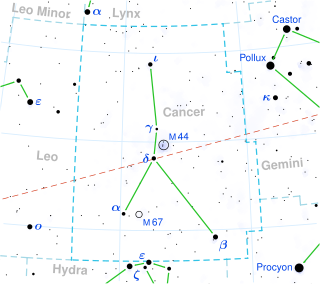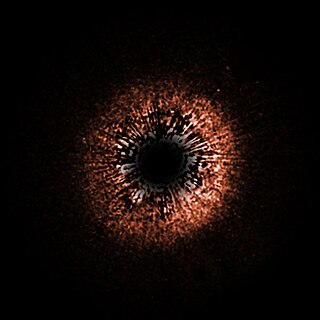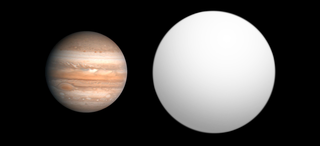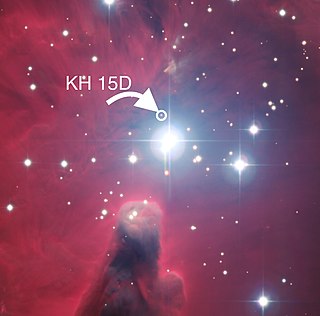Related Research Articles

A proplyd, short for ionized protoplanetary disk, is an externally illuminated photoevaporating protoplanetary disk around a young star. Nearly 180 proplyds have been discovered in the Orion Nebula. Images of proplyds in other star-forming regions are rare, while Orion is the only region with a large known sample due to its relative proximity to Earth.

A rogue planet, also termed a free-floating planet (FFP) or an isolated planetary-mass object (iPMO), is an interstellar object of planetary mass which is not gravitationally bound to any star or brown dwarf.

55 Cancri is a binary star system located 41 light-years away from the Sun in the zodiac constellation of Cancer. It has the Bayer designation Rho1 Cancri (ρ1 Cancri); 55 Cancri is the Flamsteed designation. The system consists of a K-type star and a smaller red dwarf.

2M1207, 2M1207A or 2MASS J12073346–3932539 is a brown dwarf located in the constellation Centaurus; a companion object, 2M1207b, may be the first extrasolar planetary-mass companion to be directly imaged, and is the first discovered orbiting a brown dwarf.
HD 82943 is a star with a pair of orbiting exoplanets in the equatorial constellation of Hydra. It has an apparent visual magnitude of 6.54, which is near the lower limit of visibility to the naked eye. Based on parallax measurements, the distance to this system is 90.3 light years. It is drifting further away with a heliocentric radial velocity of 8.1 km/s. The star shows a high proper motion, traversing the celestial sphere at an angular rate of 0.194 arcsec yr−1.

HD 107146 is a star in the constellation Coma Berenices that is located about 90 light-years (28 pc) from Earth. The apparent magnitude of 7.028 makes this star too faint to be seen with the unaided eye.
HD 210277 is a single star in the equatorial constellation of Aquarius. It has an apparent visual magnitude of 6.54, which makes it a challenge to view with the naked eye, but it is easily visible in binoculars. The star is located at a distance of 69.6 light years from the Sun based on parallax, but is drifting closer with a radial velocity of −20.9 km/s.

2M1207b is a planetary-mass object orbiting the brown dwarf 2M1207, in the constellation Centaurus, approximately 170 light-years from Earth. It is one of the first candidate exoplanets to be directly observed. It was discovered in April 2004 by the Very Large Telescope (VLT) at the Paranal Observatory in Chile by a team from the European Southern Observatory led by Gaël Chauvin. It is believed to be from 5 to 6 times the mass of Jupiter and may orbit 2M1207 at a distance roughly as far from the brown dwarf as Pluto is from the Sun.

Zeta Tucanae, Latinized from ζ Tucanae, is a star in the constellation Tucana. It is a spectral class F9.5 main sequence star with an apparent magnitude of +4.23. Despite having a slightly lower mass, this star is more luminous than the Sun. Based upon parallax measurements by the Hipparcos spacecraft, it is approximately 28.0 light years from Earth. This is one of the least variable stars observed during the Hipparcos mission.
94 Ceti is a trinary star system approximately 73 light-years away in the constellation Cetus.
Ray Jayawardhana is provost and professor of physics and astronomy at Johns Hopkins University. Prior to this, from 2018 to 2023, he was the Harold Tanner Dean of the College of Arts and Sciences and a Professor of Astronomy at Cornell University.

A debris disk, or debris disc, is a circumstellar disk of dust and debris in orbit around a star. Sometimes these disks contain prominent rings, as seen in the image of Fomalhaut on the right. Debris disks are found around stars with mature planetary systems, including at least one debris disk in orbit around an evolved neutron star. Debris disks can also be produced and maintained as the remnants of collisions between planetesimals, otherwise known as asteroids and comets.
HD 210277 b is an extrasolar planet orbiting the star HD 210277. It was discovered in September 1998 by the California and Carnegie Planet Search team using the highly successful radial velocity method. The planet is at least 24% more massive than Jupiter. The mean distance of the planet from the star is slightly more than Earth's distance from the Sun. However, the orbit is very eccentric, so at periastron this distance is almost halved, and at apastron it is as distant as Mars is from the Sun.

1RXS J160929.1−210524 is a pre-main-sequence star approximately 450 light-years away in the constellation of Scorpius.

CT Chamaeleontis (CT Cha) is a T Tauri star - a primary of the star system in the constellation of Chamaeleon. It has an apparent visual magnitude which varies between 12.31 and 12.43. The star is still accreting material at rate 6×10−10 M☉/year.
Scott Jay Kenyon is an American astrophysicist. His work has included advances in symbiotic and other types of interacting binary stars, the formation and evolution of stars, and the formation of planetary systems.
Stephanie A. Snedden is an American astronomer at the Apache Point Observatory of the New Mexico State University in New Mexico, United States. The minor planet 133008 Snedden is named after her; it was discovered by the Sloan Digital Sky Survey at Apache Point Observatory on 5 October 2002. She has published papers including The Case for Optically Thick High-Velocity Broad-Line Region Gas in Active Galactic Nuclei.

DI Chamaeleontis, also known as Hen 3-593 or HIP 54365, is a quadruple star system in the constellation Chamaeleon. The system is roughly 700 light years from Earth.

KH 15D, described as a winking star because of its unusual dips in brightness, is a binary T Tauri star system embedded in a circumbinary disk. It is a member of the young open cluster NGC 2264, located about 2,500 light-years (770 pc) from the Sun in the constellation of Monoceros.

A circumplanetary disk is a torus, pancake or ring-shaped accumulation of matter composed of gas, dust, planetesimals, asteroids or collision fragments in orbit around a planet. They are reservoirs of material out of which moons may form. Such a disk can manifest itself in various ways.
References
- 1 2 "Minor Planet Discoverers (by number)". Minor Planet Center. 20 June 2016. Retrieved 6 August 2016.
- ↑ Schmadel, Lutz D. (2007). "(36614) Saltis [2.37, 0.16, 1.8]". Dictionary of Minor Planet Names – (36614) Saltis, Addendum to Fifth Edition: 2003–2005. Springer Berlin Heidelberg. p. 203. doi:10.1007/978-3-540-34361-5_2392. ISBN 978-3-540-00238-3.
- ↑ "36614 Saltis (2000 QU148)". Minor Planet Center. Retrieved 19 March 2016.
- ↑ "122310 (2000 QJ9)". Minor Planet Center. Retrieved 19 March 2016.
- ↑ "239890 Edudeldon (2000 RX11)". Minor Planet Center. Retrieved 19 March 2016.
- ↑ "297409 Mallgan (2000 RE39)". Minor Planet Center. Retrieved 19 March 2016.
- ↑ Alexis Brandeker (20 June 2016). "Alexis Brandeker – About" . Retrieved 6 August 2016.